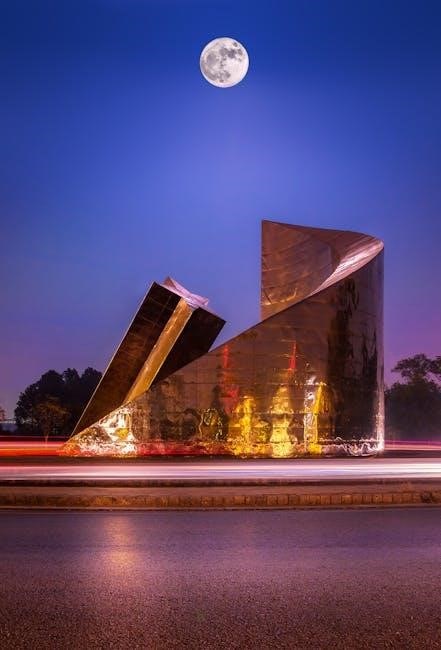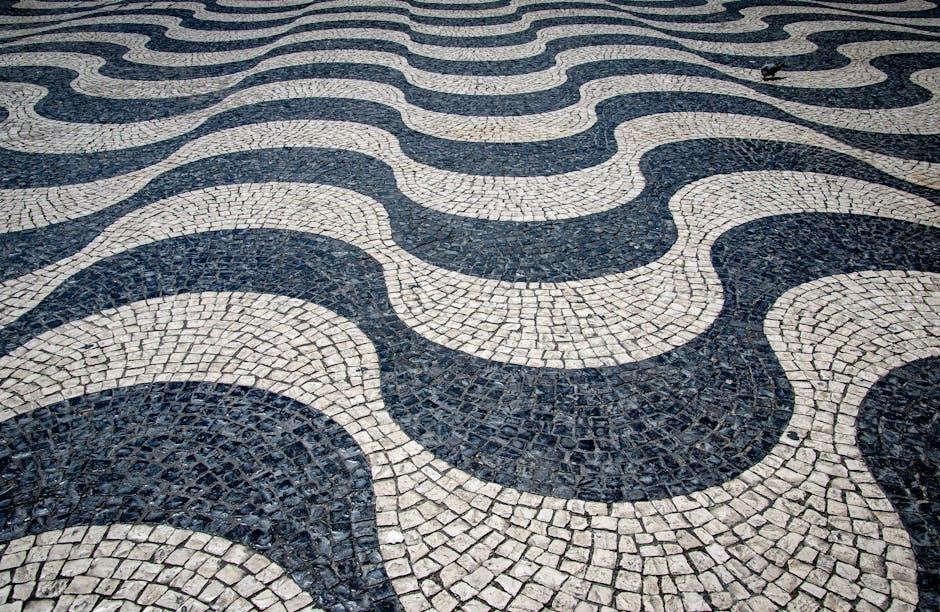Erik Larson’s The Devil in the White City masterfully intertwines the 1893 Chicago World’s Fair’s brilliance with the dark tale of H.H. Holmes‚ crafting a historical narrative.
1.1 Overview of the Book
The Devil in the White City by Erik Larson is a gripping historical narrative that explores the 1893 Chicago World’s Fair and the sinister crimes of H.H. Holmes. The book masterfully weaves together the stories of architect Daniel H. Burnham‚ who built the “White City‚” and Holmes‚ a serial killer who exploited the fair’s grandeur. Larson’s vivid storytelling brings the Gilded Age to life‚ blending history with suspense.
The 1893 Chicago World’s Fair‚ or the World’s Columbian Exposition‚ was a pivotal event showcasing American innovation and culture. Held during the Gilded Age‚ it symbolized Chicago’s rise as a major city. The fair featured groundbreaking architecture and inventions‚ attracting millions of visitors. This setting provided the backdrop for both the fair’s triumph and the shadow of H.H. Holmes’ crimes. Erik Larson masterfully intertwines the stories of Daniel H. Burnham‚ the visionary architect behind the 1893 Chicago World’s Fair‚ and H.H. Holmes‚ a charming yet sinister serial killer. While Burnham’s ambition and creativity shaped the fair’s splendor‚ Holmes exploited its grandeur to commit heinous crimes. This dual narrative contrasts brilliance with darkness‚ mirroring the duality of human nature. The 1893 Chicago World’s Fair was a groundbreaking event showcasing American innovation‚ culture‚ and architectural brilliance‚ symbolizing the nation’s progress and unity. The 1893 Chicago World’s Fair was conceived to showcase America’s industrial prowess and cultural advancement. Organizers envisioned a spectacular event to surpass Paris’s 1889 Exposition‚ highlighting innovation and unity. The fair aimed to celebrate the 400th anniversary of Columbus’s arrival‚ while also demonstrating Chicago’s rise as a global city‚ blending progress with entertainment. The 1893 Chicago World’s Fair introduced groundbreaking architecture‚ showcasing the “White City” with its neoclassical designs and innovative use of materials. The Administration Building and Transportation Building highlighted the “Chicago School” style‚ blending functionality with grandeur. Electricity illuminated the fairgrounds‚ a novel feature at the time‚ while architects like Daniel Burnham pushed creative boundaries‚ leaving a lasting impact on modern architecture. The 1893 Chicago World’s Fair symbolized American ingenuity and progress‚ uniting the nation in a celebration of innovation and culture. It showcased technological advancements‚ artistic achievements‚ and global unity‚ leaving a lasting impact on American identity. The fair’s grandeur and accessibility inspired national pride‚ setting a benchmark for future expositions and cementing its place in cultural history. Daniel H. Burnham was the visionary architect behind the 1893 Chicago World’s Fair‚ showcasing his leadership and innovative designs that left a lasting legacy in American architecture. Daniel Burnham played a pivotal role in the 1893 Chicago World’s Fair‚ leading its construction with unwavering dedication. His architectural genius and organizational skills ensured the fair’s structures were both awe-inspiring and functional. Burnham’s ability to manage vast resources and collaborate with fellow visionaries brought the fair to life‚ despite numerous challenges and setbacks during its planning and execution phases. His work remains a testament to his enduring legacy. Daniel Burnham’s contributions to American architecture were profound‚ blending innovative design with grandeur. His work on iconic buildings like the Flatiron Building and Union Station showcased his mastery of neoclassical styles. Burnham’s influence extended beyond structures; he co-founded the American Institute of Architects‚ promoting architectural professionalism. His legacy endures through landmarks that define urban skylines and inspire future architects. Daniel Burnham faced numerous challenges while planning the 1893 World’s Fair‚ including tight deadlines‚ budget constraints‚ and logistical complexities. Coordination among architects‚ engineers‚ and laborers was daunting. Weather conditions and political pressures added to the strain. Despite these obstacles‚ Burnham’s relentless leadership ensured the Fair’s success‚ transforming Chicago into a global spectacle and setting new standards for urban development. H.H. Holmes‚ a charming and cunning figure‚ became infamous as one of America’s first serial killers‚ using the 1893 World’s Fair to lure victims to his deadly trap. H.H. Holmes‚ born Herman Webster Mudgett‚ was a charismatic pharmacist who disguised his sinister nature. Using the 1893 Chicago World’s Fair‚ he lured victims into his “murder castle‚” a hotel equipped with secret rooms and traps. His crimes shocked the nation‚ marking him as one of America’s first documented serial killers‚ with estimates of up to 27 victims during the fair. The 1893 Chicago World’s Fair attracted millions‚ creating an anonymous environment where H.H. Holmes thrived. His hotel‚ designed with hidden passages and soundproof rooms‚ became a hunting ground. The fair’s transient population and Holmes’ charm allowed him to target vulnerable visitors‚ exploiting their trust and the city’s excitement to commit heinous acts undetected. His crimes were facilitated by the fair’s bustling atmosphere and anonymity. H.H; Holmes’s crimes at the 1893 World’s Fair left a lasting impact on American crime history. His actions led to significant changes in law enforcement strategies and raised public awareness about serial offenders. Erik Larson’s book brought Holmes’s story to the forefront‚ influencing the true crime genre and inspiring various adaptations‚ ensuring his dark legacy endures in popular culture. Erik Larson’s masterful storytelling weaves history and drama seamlessly‚ crafting a cinematic narrative. His meticulous research and engaging prose bring the Gilded Age to vivid life. Erik Larson masterfully blends historical facts with engaging storytelling‚ creating a vivid narrative that feels cinematic. His meticulous research and dramatic flair bring the 1893 Chicago World’s Fair and H.H. Holmes’s sinister actions to life‚ captivating readers with a blend of truth and tale. Larson’s ability to weave history into a compelling story sets his work apart. Erik Larson employs dramatic storytelling to captivate readers‚ transforming historical events into a gripping narrative. By focusing on the contrasting lives of Daniel Burnham and H.H. Holmes‚ he creates tension and depth‚ making the 1893 World’s Fair and its dark underbelly feel both real and riveting. This approach ensures the book is both informative and thrilling. Erik Larson’s meticulous research is evident in The Devil in the White City. He weaves historical facts with vivid descriptions‚ ensuring accuracy while maintaining a narrative flow. Larson’s attention to detail brings the 1893 World’s Fair and its characters to life‚ making the book both historically authentic and engaging for readers. His dedication to precision enhances the story’s credibility. The book explores themes of progress and darkness‚ symbolizing America’s ambition through the 1893 World’s Fair‚ while contrasting light and shadow in human endeavors. The book vividly contrasts Daniel Burnham’s visionary architecture and H.H. Holmes’s sinister crimes‚ symbolizing the duality of progress and darkness. Burnham’s contributions to the 1893 World’s Fair highlight human achievement‚ while Holmes’s atrocities reveal the shadows of ambition. Larson’s narrative masterfully interweaves these opposing forces‚ illustrating the coexistence of good and evil in a transformative era. The book explores how ambition and obsession shape human destiny. Daniel Burnham’s relentless drive to create the perfect World’s Fair exemplifies constructive ambition‚ while H.H. Holmes’s obsession with manipulation and murder reveals its destructive counterpart. Larson’s narrative underscores the fine line between visionary goals and dangerous fixation‚ highlighting the dual nature of human achievement and darkness. The 1893 World’s Fair marked a pivotal moment in Chicago’s history‚ transforming it from a post-fire recovery city to a symbol of innovation and culture. The fair showcased Chicago’s potential‚ blending architectural marvels with cultural exhibits‚ and left a lasting legacy that reshaped its identity and solidified its place in American history as “The White City.” The book received widespread acclaim for its vivid storytelling‚ earning it a No. 1 spot on the New York Times bestseller list and an Edgar Award. The Devil in the White City became a No. 1 New York Times bestseller‚ praised for its gripping narrative. It won an Edgar Award and was a National Book Award finalist. Larson’s ability to weave history with compelling storytelling earned widespread critical acclaim‚ making the book a landmark in historical non-fiction and a favorite among readers and scholars alike. Erik Larson’s The Devil in the White City received numerous accolades‚ including the Edgar Award for Best Fact Crime. It was also a finalist for the National Book Award‚ showcasing its excellence in historical narrative. These recognitions highlight the book’s meticulous research and engaging storytelling‚ solidifying its place in literary achievements. The Devil in the White City became a New York Times bestseller‚ with over twelve million copies sold worldwide. Its compelling narrative and historical depth inspired a planned film adaptation by Leonardo DiCaprio and Martin Scorsese. The book’s success revitalized interest in the 1893 World’s Fair and cemented its status as a landmark in historical non-fiction‚ leaving a lasting legacy in popular culture. The book’s cinematic potential led to a planned film adaptation by 20th Century Studios‚ with Martin Scorsese directing and Leonardo DiCaprio starring. Erik Larson’s The Devil in the White City is set to be adapted into a film by 20th Century Studios‚ with Martin Scorsese directing and Leonardo DiCaprio starring. The project‚ long in development‚ has recently resumed progress‚ promising to bring the book’s dual narrative of Burnham and Holmes to the screen with cinematic flair. Leonardo DiCaprio is set to star in the film adaptation‚ with Martin Scorsese directing‚ bringing their cinematic expertise to Larson’s story. DiCaprio’s involvement underscores the project’s prestige‚ while Scorsese’s direction promises a gripping narrative. Their collaboration aims to capture the book’s dual tale of ambition and horror‚ ensuring a compelling cinematic experience. Adapting The Devil in the White City into a film presents significant challenges due to its intricate dual narrative and historical depth. The book’s non-fiction roots require precise storytelling to maintain accuracy while engaging audiences. Balancing the scales of Burnham’s architectural brilliance and Holmes’ dark crimes demands meticulous attention to detail‚ ensuring the film captures the essence of Larson’s gripping account without sacrificing complexity. Erik Larson’s The Devil in the White City has significantly influenced the true crime genre‚ inspiring numerous adaptations and renewing interest in the 1893 World’s Fair. Erik Larson’s The Devil in the White City revolutionized the true crime genre by blending meticulous research with compelling storytelling. Its cinematic narrative style has inspired countless authors and adaptations‚ making it a benchmark for historical crime narratives. The book’s success has also sparked renewed interest in H.H. Holmes‚ solidifying his place in American criminal history. Its impact continues to shape the genre. Erik Larson’s The Devil in the White City sparked a resurgence of interest in the 1893 Chicago World’s Fair‚ highlighting its architectural marvels and cultural significance. The book’s vivid portrayal of the fair’s grandeur and challenges has led to increased historical appreciation‚ inspiring new studies and discussions about its legacy in American history and innovation. The Devil in the White City has inspired numerous creative projects‚ including documentaries‚ podcasts‚ and even a planned film adaptation. Its narrative style has influenced other historical non-fiction writers‚ encouraging a more engaging approach to storytelling. The book’s success has also sparked interest in historical events‚ leading to new books and educational programs about the 1893 World’s Fair and its legacy. The Devil in the White City remains a timeless blend of history and suspense‚ offering insights into ambition‚ evil‚ and Chicago’s transformation‚ leaving a lasting cultural impact. Erik Larson’s The Devil in the White City masterfully intertwines the brilliance of the 1893 Chicago World’s Fair with the chilling story of H.H. Holmes. The book highlights Daniel Burnham’s architectural feats and Holmes’s sinister crimes‚ exploring themes of ambition‚ evil‚ and innovation. It captures the cultural significance of the fair and its lasting impact on American history‚ cementing the book’s legacy as a gripping historical narrative. Erik Larson’s The Devil in the White City has left a lasting impact‚ earning acclaim and awards‚ including the Edgar Award and National Book Award nomination. Its adaptation‚ involving Leonardo DiCaprio and Martin Scorsese‚ underscores its cinematic potential. The book’s success has influenced the true crime genre‚ sparked renewed interest in the 1893 World’s Fair‚ and inspired numerous adaptations and works‚ solidifying its cultural significance. Erik Larson’s The Devil in the White City stands as a masterclass in blending meticulous research with compelling storytelling‚ offering insights into ambition‚ innovation‚ and darkness. Its enduring popularity highlights its ability to captivate diverse audiences‚ solidifying its place as a landmark in historical non-fiction and a testament to the power of storytelling in understanding the past.1.2 Historical Context of the 1893 Chicago World’s Fair
1.3 The Dual Narrative: Burnham and Holmes

The 1893 Chicago World’s Fair
2.1 The Vision Behind the Fair

2.2 Architectural Marvels and Innovations
2.3 The Cultural Significance of the Fair

Daniel H. Burnham: The Architect
3.1 Burnham’s Role in the Fair’s Construction
3.2 His Contributions to American Architecture
3.3 Challenges Faced During the Fair’s Planning
H.H. Holmes: The Serial Killer
4.1 The Life and Crimes of H.H. Holmes
4.2 How the Fair Enabled His Crimes
4.3 The Historical Impact of His Actions

Erik Larson’s Writing Style
5.1 Blending History and Narrative
5.2 The Use of Dramatic Storytelling
5.3 Research and Accuracy in the Book

Themes and Symbolism

6.1 The Contrast Between Good and Evil
6.2 The Role of Ambition and Obsession
6.3 The Transformation of Chicago
The Book’s Reception and Awards

7.1 Critical Acclaim and Reviews
7.2 Awards and Nominations
7.4 The Book’s Popularity and Legacy
Adaptations and Media
8.1 The Planned Film Adaptation
8.2 The Role of Leonardo DiCaprio and Martin Scorsese
8.3 The Challenges of Adapting the Book

The Book’s Impact on Popular Culture
9.1 Influence on True Crime Genre
9.2 Renewed Interest in the 1893 World’s Fair
9.3 Inspiration for Other Works
10.1 Summary of Key Points
10.2 The Enduring Legacy of the Book

10.3 Final Thoughts on the Book’s Significance